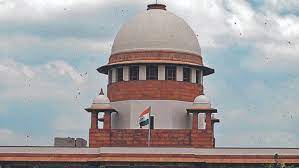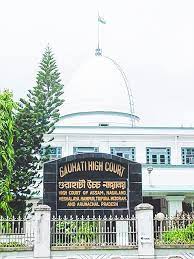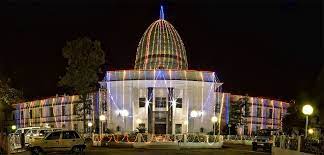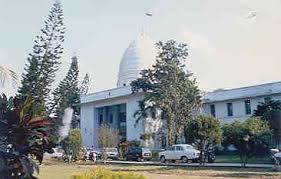Against whom proceedings have been initiated on account of default in repaying financial facilities extended to them by several banks in the form of loans and bank guarantees. The total claim on account of default as made before the National Company Law Tribunal (NCLT) was for a sum of Rs.613,27,01,598.23 (Para 1)
Hence, the State Bank of India is now prosecuting the composite claims of these banks. In the proceeding before the NCLT, out of which this appeal arises, it was the State Bank of India who had filed the application as financial creditor under Section 7 of the Insolvency and Bankruptcy Code, 2016 (IBC). (Para 1)
The State Bank of India’s application under Section 7 of the IBC was filed on 06.09.2019 before the NCLT, founded on all the three recovery certificates in which the first respondent had substantial stake. In its order passed on 12.01.2021, the adjudicating authority admitted the application and declared moratorium in terms of Section 14 of the IBC. (Para 3)
The NCLT had taken into consideration a letter issued by the corporate debtor on 29.01.2020 addressed to the Union Bank and the State Bank of India, agreeing in principle to repay the amount due to the financial creditors. The same letter requested the banks to support the corporate debtor during the financial crises being faced by them and sought waiver of penal interest levied. A request for one time settlement was also made in this communication. The NCLT treated this letter to be an acknowledgement of debt. In its decision taken on 12.01.2021 while admitting the application, it was, interalia, observed (Para 3)
The pleas of the appellant before the Appellate Tribunal were mainly on procedural grounds. Apart from the question of limitation, arguments were advanced that the application before the NCLT was barred under the doctrine of election, the borrower having chosen the SARFAESI mechanism first and having applied before the DRT. Point of limitation was also reiterated. On the issue involving the RBI Circular dated 12.02.2018 the case of the appellant was that the banks had approached the forum under the IBC, on the basis of the aforesaid circular. The said circular was, however, quashed in the case of Dharani Sugars and Chemicals Ltd. (supra). On this ground, the appellant argued that the application was not maintainable. (Para 4)
Limitation. The provisions of the Limitation Act, 1963 (36 of 1963) shall, as far as may be, apply to the proceedings or appeals before the Adjudicating Authority, the National Company Law Appellate Tribunal, the Debt Recovery Tribunal or the Debt Recovery Appellate Tribunal, as the case may be. (Para 6)
We accept the submission of the appellant that this letter was a request to consider a onetime settlement. But again, in absence of averments or pleading, after initiation of insolvency proceeding, any promise made to pay the debt cannot be treated to have cured the fault of limitation in a preexisting action. A promise of this nature would constitute an independent cause of action. (Para 9)
On behalf of the appellant, submissions have been made that the banks having approached the DRT, were barred under the doctrine of election from approaching the NCLT for recovery of same set of debts. This is a doctrine embodied in the law of evidence, which bars prosecution of the same right in two different fora based on the same cause of action. But so far as the present appeal is concerned, the recovery proceedings before the DRT had commenced in the year 2014. At that point of time, the IBC had not come into existence. (Para 11)
The question of election between the fora for enforcement of debt under the 1993 Act and initiation of CIRP under the IBC arises only after a recovery certificate is issued. The reliefs under the two statutes are different and once CIRP results in declaration of moratorium, the enforcement mechanism under the 1993 Act or the SARFAESI Act gets suspended. In such circumstances, after issue of recovery certificate, the financial creditor ought to have option for enforcing recovery through a new forum instead of sticking on to the mechanism through which recovery certificate was issued. In the case of Transcore vsUnion of India and Another [(2008) 1 SCC 125], application of SARFAESI mechanism was held permissible even though the subject proceeding was instituted under the 1993 Act. Thus, the doctrine of election cannot be applied to prevent the financial creditors from approaching the NCLT for initiation of CIRP. (Para 11)
A question that arises now is as to whether the debts in connection with the recovery certificate issued in the year 2015 could form subject matter of an application under Section 7 of the IBC filed on 06.09.2019. In the case of Kotak Mahindra I (supra), it was held that CIRP could be brought within three years from the date of issue of recovery certificate. (Para 12)
What has been filed before the NCLT is a composite application based on three recovery certificates, two of which have been instituted within the three-year period as postulated in Article 137 of the Limitation Act. The third recovery certificate was issued in the year 2015. Thus, there is more than three years gap between the date of issue thereof and the date of filing of the application before the NCLT. But a recovery certificate under the 1993 Act is also clothed with the character of a deemed decree. (Para 13)
There is authority for the proposition that the time for computing limitation period for filing an application under Section 7 of the IBC would be guided by Article 137 of the Limitation Act. (Para 14)
We have already referred to the provision of Section 19(22A) of the 1993 Act. This Court has construed the purpose of the said provision to include bringing an action under the IBC on the strength of Section 19(22) and (22A) of the 1993 Act. In the said provision, however, so far as bringing a winding up action is concerned, the right of a recovery certificate holder as a deemed decree holder has been confined to companies registered under the Companies Act, 2013 and certain other entities with which we are not concerned here. But in relation to initiating proceeding under the IBC or making a claim under the said Code, the restriction does not remain confined to the Companies Act, 2013. The corporate debtor in this proceeding was incorporated under the Companies Act, 1956 (Para 15)
In the event a financial creditor wants to pursue a recovery certificate as a deemed decree, he would get twelve years’ time. (Para 15)
But since the first two fora did not test the legality of the 2015 certificate as a deemed decree, we are of the opinion that this question also ought to be addressed by the Appellate Tribunal. We are otherwise not satisfied with the argument of the appellant about maintainability of the application out of which this appeal arises on the ground of the application being barred under limitation. The application with respect to the two recovery certificates issued in the year 2017 is maintainable. (Para 15)
SUPREME COURT OF INDIA
2023 STPL(Web) 353 SC
[2023 INSC 923]
Tottempudi Salalith Vs. State Bank Of India & Ors
Civil Appeal No.2348 of 2021-Decided on 18-10-2023.
https://stpllaw.in/wp-content/uploads/2023/10/2023-STPLWeb-353-SC.pdf







